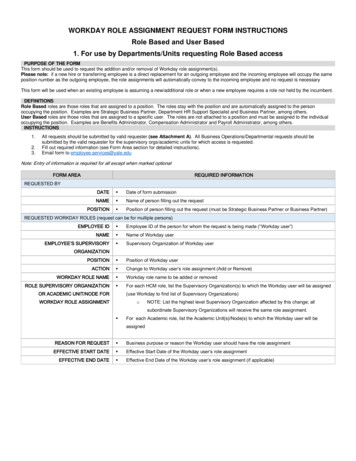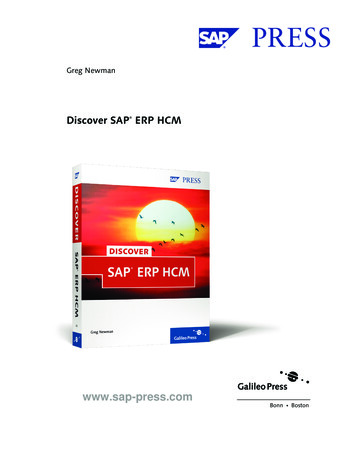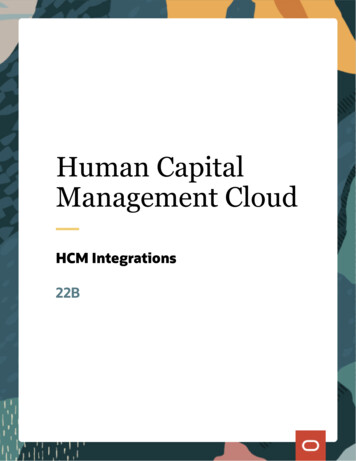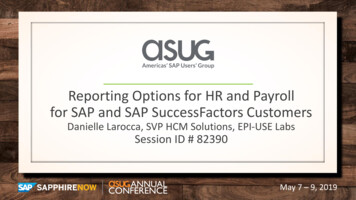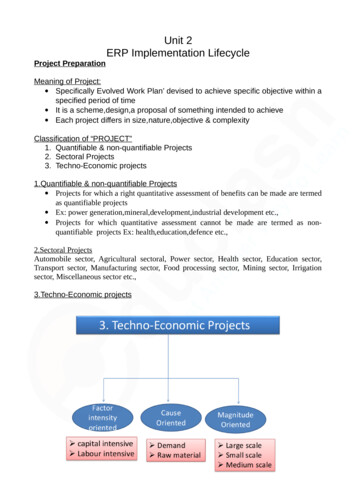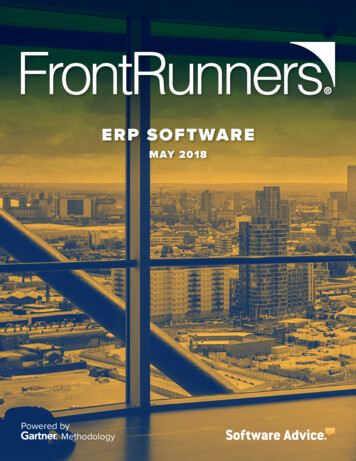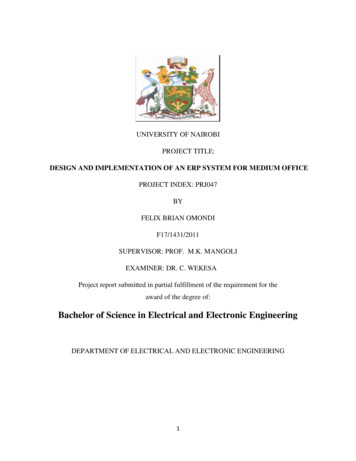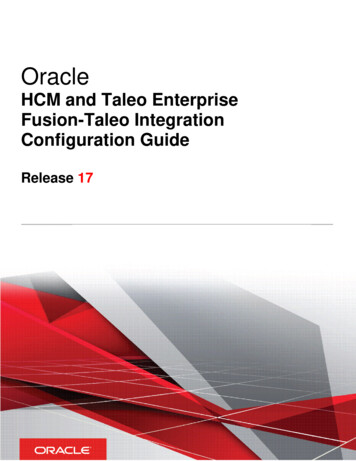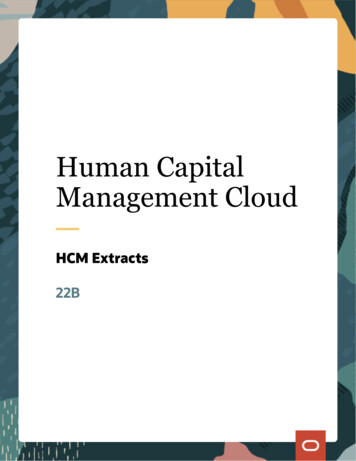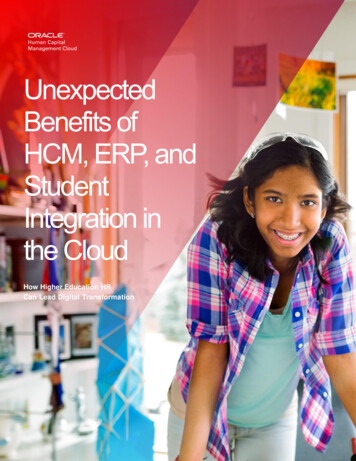
Transcription
UnexpectedBenefits ofHCM, ERP, andStudentIntegration inthe CloudHow Higher Education HRCan Lead Digital Transformation
Moving information systems to the cloud is hardly a novel idea; eachyear, the percentage of higher education institutions that move their HCM,ERP, and Student systems to the cloud grows. And when you look at thedata, it’s easy to understand why: a unified cloud system has farreaching, concrete benefits that touch nearly all aspects of campusoperations and the overall student, faculty, and staff experience.Institutional leadership often cite advantages such as cost efficiencies,student success, optimized workflows, employee engagement, andreduced maintenance as top motivators for unifying HCM, ERP, andStudent systems in the cloud. In addition, as higher education focuses onsustainability and the need to graduate more students, improved insightacross the institution can impact key areas like student and employeeretention.But beyond the clear benefits of bringing HR, finance, and studentmanagement together, colleges and universities can gain unexpectedbonuses as well, particularly in areas of special interest to HR. Cloudplays a pivotal role in the transformation of the HR function into a morestrategic team, but just as importantly, cloud technology can also uniquelyposition HR to lead a fundamental shift in the way institutions operate atevery level. Research by MIT Technology Review Custom, sponsored byOracle, uncovered three unexpected yet transformational outcomesbringing these functional areas together that underscore its sweepingeffects on HR and beyond.1CLOUD INTEGRATION EXPOSES SKILL GAPSThough it may seem counterintuitive, revealing the need for additional skilldevelopment is a huge, if unforeseen, bonus to cloud integration. After all, thetransition to cloud rarely creates skill gaps; it merely exposes those that alreadyexist. Understanding where the institution is strong and where there is room forimprovement is a boon to any campus, and HR is uniquely positioned to tacklethese opportunities head on.2Unexpe cted Benefits of HCM, ERP, an d Student Integration in the Cloud: How Higher Education HR Can Lead Digital Transformation
While cloud integration allows for more time to be spent on value-added endeavorsin theory, some organizations found that they didn’t quite reap the hoped for results.Investigation into the issue revealed two major skill gaps that needed to beremedied: collaboration between teams and time management.2Integrated cloud solutions can provide big benefits to institutions, but implementingthe right technology alone isn’t enough. Change management is an importantcomponent of rolling out new technology in higher education because it’s critical toeducate the entire campus community about the purpose and outcomes anticipatedwith new technology investments. Once key influencers get onboard with thechanges—they can help others adopt a more agile, innovative mindset.But this doesn’t necessarily happen overnight. When teams are used to owningtheir own projects, processes, and decisions, it can be difficult to convince them toshare the load. Inviting other teams into the decision-making process can feelthreatening, especially when trust between these teams has not been previouslyestablished. Harvard Business Review found that while workers tend to trust theirown teammates, trust between teams is as low as 50 percent.3 And CEB researchdiscovered that a whopping 75 percent of employees believe their coworkers arelikely to behave unethically.4 CEOs know this is a problem; a PwC survey found that55 percent of CEOs believe lack of trust is a threat to their organization.5“40%of HR and financerespondents say timemanagement skillsneed improving.”1MIT Technology ReviewCustomIn addition, some faculty and staff are reluctant to change their workstyle—evenwhen it’s more efficient to do so—because they don’t make a connection betweentheir work and student success, or because they don’t see how they will benefitfrom the change. Or they may be persuaded to make a change, but they see noreason to make the change immediately. Thus, they end up using their time the waythey always have, resulting in lost opportunities for improvement. If the people inthe trenches doing the work aren’t making the most of their own skills, the institutioncan’t thrive—no matter what technology is provided.Luckily, these challenges can be addressed through cultural and operationalchanges. Collaboration and communication skills can be developed with crosstraining and one-to-one coaching and facilitated by shared platforms that enablesocial and collaborative behaviors. Managers can engender trust across teamsthrough peer-based recognition programs, challenging group projects, and oldfashioned team building.63Unexpe cted Benefits of HCM, ERP, an d Student Integration in the Cloud: How Higher Education HR Can Lead Digital Transformation
Improving time management skills may take both training and a rethinking of howprojects are handled. Currently, many teams operate under a laundry list ofgoverning processes and workflows—many of which are slow, laborious, anddestroy employee motivation.7The move to cloud frees teams to reevaluate their processes as they integrate theirworkloads into a new solution. Unwieldy, unproductive, or overly restrictiveworkflows and processes can be culled or revised to be less cumbersome onproduction and creativity. Transitioning from waterfall processes with their long leadtimes and slow delivery to more iterative, agile models grants individuals and teamsthe opportunity to change their work habits—and their mindsets. By experimentingwith work models that rely on continuous delivery and continuous innovation, facultyand staff will find new ways of working that are more efficient, and the institution willfinally see the productivity yield they expected.UNIFYING HCM, ERP, AND STUDENT DELIVERS INSTITUTIONALEXCELLENCEColleges and universities who have completed their transition to the cloud haveseen institutional excellence in action, from increased productivity, to cost savings,and better strategic planning and decision making.84Unexpe cted Benefits of HCM, ERP, an d Student Integration in the Cloud: How Higher Education HR Can Lead Digital Transformation
Putting HCM, ERP, and Student in a single cloud enables more intelligence andagility—helping prepare higher education for the next decade. By 2025, 75 percentof the workforce will be comprised of millennials. At the same time, the workforce ismore global, mobile, and diverse than ever before. Institutions are responding byputting more emphasis on diversity in hiring, starting succession plans for retiringuniversity leadership, and preparing to compete for students in the changingeducation landscape. Many institutions arediscovering that their processes, workflows,and strategies are not ready for this fastapproaching future. One way that colleges andCOLLABORATIONuniversities are meeting this challenge isBETWEEN HR,through digital transformation—the institutionFINANCE, ANDwide adoption of technology to enable newSTUDENT SYSTEMStypes of innovation, collaboration, andresearch.YIELDS MEASURABLEROI AND DEFINESIntegrated HCM, ERP, and Student systemsshare a single source of data. People data andTHE PATH FORfinancial data reside in the same place, andCULTURAL SHIFTSrecords can be cross-referenced to form aACROSS THEmore complete picture of how different parts ofINSTITUTION.the campus interact. One example is studentworkers and making sure any employment astudent begins is recorded in both the HCM and Student applications.With a unified system, HR, finance, enrollment, and academic leaders can speakthe same language, facilitating better collaboration and faster decision making.Integrating the datasets between HR and finance allows these leaders to glean newvisibility and insight into the institution’s real health—from both financial andworkforce perspectives.And, importantly, those learnings spread throughout the institution, informing howlearning is conducted, people are hired, problems are solved, and dollars are spent.This organic transformation is powerful, creating new value and opportunities as theinstitution evolves. Collaborative leadership between HR and finance, for example,may challenge attitudes about functional territories and begin to correct misalignedobjectives or KPIs. In this way, successful collaboration not only yields measurableROI, it also illuminates the path toward fundamental shifts in culture that producegreater agility and innovation.5Unexpe cted Benefits of HCM, ERP, an d Student Integration in the Cloud: How Higher Education HR Can Lead Digital Transformation
EXECUTING A UNIFIED CLOUD STRATEGY PREPARES THEINSTITUTION FOR THE NEXT DISRUPTIONDeloitte’s 2018 Global Human Capital Trends report identified “symphonicleadership” as one of the key trends transforming business today.9 Defined as amodel where executives interact and support each other as a single team whilecontinuing to lead their own departments, symphonic leadership is both arequirement for and a byproduct of an interconnected enterprise. As highereducation institutions evolve and gain access to more data, analysis will becomemore complex, and HR’s ability to plan for market changes and the social forcesthat shape them will become a vital bulwark against disruption. A close partnershipwith finance, enrollment management, and other departments that can provideaccess to student and financial analysis helps make such foresight possible.But such partnerships aren’t necessarily easy to develop or maintain. Old habitsmay be difficult to break, and the learning period where HR, finance, and studentteams adapt to their new roles and relationships may be rocky at first. But theoutcome of this challenge will be new skills—collaborative, interpersonal skills thatthe rest of the institution will also need to learn to remain competitive. In this way,HR’s partnership with other functional areas becomes a model for the entireinstitution.6Unexpe cted Benefits of HCM, ERP, an d Student Integration in the Cloud: How Higher Education HR Can Lead Digital Transformation
Executives aren’t the only ones who may need an adjustment period. As cloudintegration allows for more time and resources to be spent on higher value,strategic initiatives, managers and individual contributors alike may need tostrengthen muscles that were previously underdeveloped. But in doing so, facultyand staff become more adaptable, more amenable to change, and better able toprepare for disruption. When individuals and teams are accustomed to flexible workmodels predicated on the ability to meet fluctuating needs, meeting the changingexpectations of students and the community becomes second nature.THE EMERGING TECHNOLOGY ADVANTAGEFuture-ready institutions are doing more than preparing their people for disruption.Increasingly, HR leaders are enlisting the help of artificial intelligence (AI) tonavigate the churning seas of change.10 And to be useful, that AI must be taught—fed with relevant data and coached into producing acceptable, usable outcomes.But AI is only as useful as the data it has, making unified data sets between HR,finance, enrollment management, and other departments even more valuable.7Unexpe cted Benefits of HCM, ERP, an d Student Integration in the Cloud: How Higher Education HR Can Lead Digital Transformation
Armed with the right information and the right coaching, AI is poised to alleviatemany of the burdens HR currently faces, such as overtaxed resources and timespent on mundane tasks. Chatbots, for example, will become welcome newmembers of many HR teams. From facilitating the update of employee records tofielding common questions and redirecting inquiries, AI can improve employeeexperiences while allowing humans to do more strategic work.Other new technologies are making headway into organizations, too. According toGartner, blockchain, for example, “has potential to kick-start a platform evolution orrevolution within the next 5-10 years.”11 Blockchain is poised to become the futureof business transactions, and if institutions aren’t prepared to utilize the technology,they may find themselves behind. Integrating or sharing services between andamong networks is only becoming more vital, and savvy leaders are looking to takeadvantage of these abilities now—before they become table stakes.Disruption usually comes from outside—an external force whose extreme pressureeither changes or breaks an industry. In higher education, there have been manyforces of disruption from MOOCs and online certifications to changes in funding andskepticism about the value of a four-year degree.INSTITUTIONS THATINVEST IN EMERGINGTECHNOLOGIES WILLBE BETTEREQUIPPED TOSURVIVEDISRUPTION.8Institutions that invest in emergingtechnologies and integrated solutions stand afighting chance not only of withstandingdisruption, but taking advantage of it.Institution-wide alignment on goals and vision,the ability to restructure teams to focus oninnovation and experimentation, and the abilityto move quickly lie at the heart of disruption.And these are all areas that HR can lead withconfidence, supported by the right technologyand business processes.Unexpe cted Benefits of HCM, ERP, an d Student Integration in the Cloud: How Higher Education HR Can Lead Digital Transformation
HOW CAN HR MAXIMIZE THESE BENEFITS AND LEAD THROUGHDISRUPTION?To make the most of their organization’s digital transformation and prepare tobecome the next disruptor, HR needs to focus on three fundamental areas:institutional readiness, prescriptive data analysis, and automation.Any fundamental shift in operations can create challenges. And even though thecoming changes may prove highly beneficial in the long run, most campuses cannotafford to have their everyday activities significantly interrupted. Even during this tidalwave of change, each day must be business as usual—and HR can help create thatcenter of calm amid the storm.Ensure Institutional ReadinessIn times of change, many HR functions focus on change management—ensuringthat people understand the change, how it applies to them, and how they cantransition from the past into the future. And it’s a necessary activity. But future-readyHR teams can’t stop there.9Unexpe cted Benefits of HCM, ERP, an d Student Integration in the Cloud: How Higher Education HR Can Lead Digital Transformation
Ensuring change is least disruptive to people is one thing; ensuring change is leastdisruptive to the institution is another. HR can protect the institution frominterruptions and continuity challenges with five key strategies:–Use fundamental knowledge of the institution—financial, strategic, andtechnological capability—to inform hiring and training decisions–Provide data-driven insights about the institution and its people–Go beyond change management to change leadership, modeling a culture ofchange as the new normal–Provide cross-training with an emphasis on developing collaborative problemsolving skills“Oracle HumanCapital ManagementCloud will allow ourstaff greater controland access of theirown data, and makeHR processes quicker,easier, moreconsistent, and moretransparent. This willsignificantly improveexperience to the5,000 plus staff andassociates working atthe University.”–Challenging the status quo and investigating new work models, collaborationmethods, and internal processes— Sally Stewart, Director ofHuman Resources, BirminghamCity UniversityBecome Master Consumers of DataIf that sounds like a heavy undertaking, it is. But HR teams don’t have to do it alone.Today’s unified HCM, ERP, and Student systems provide the rich data teams needto make informed decisions. Predictive analytics allows HR to not only understandwhat is happening across campus, but also to predict a timeline for when certainactions should be taken, such as when an employee should be considered for araise or promotion. And to take it one step further, future-ready HR leaders are alsolearning to use AI to prescribe specific actions that benefit the institution in thelonger term. For example, data analysis may indicate that the abovementionedemployee is at risk of leaving, and AI-augmented prescriptive analysis mayrecommend offering him a career advancement or development opportunity.HR teams have long been data creators: performance reviews, compensationhistory, turnover rates etc. are common in every HR toolkit. But to lead theinstitution through disruption, HR needs to evolve from pure data creators tobecoming data consumers. HR must learn to understand the numbers in ways thatallow them to make thoughtful, meaningful predictions about the future of theinstitution.10Unexpe cted Benefits of HCM, ERP, an d Student Integration in the Cloud: How Higher Education HR Can Lead Digital Transformation
Embrace AutomationIn addition to understanding the numbers, HR will need to share information withteams across the institution. But standard reporting is quickly becoming outdated,as HCM, ERP, and Student systems move to the cloud. AI, machine learning, andpattern recognition can automate routine human resource management tasks whilereducing dependence on custom reports. Reports become configurabledashboards, allowing stakeholders to retrieve the information they need in waysthat make sense to them. That automation results in better, more timely reportingand fewer resources spent on the data integration required for custom reports.Automation is here to stay, and forward-thinking institutions are already looking forways to capitalize on it. Automation will move throughout the campus, and manyjobs will evolve as certain skillsets are displaced and the need for new skillsetsarises. While this evolution will not be without challenges, the resulting ability tomove faster and respond quicker to student needs and expectations will beinvaluable.CONCLUSIONHCM, ERP, and Student integration in the cloud has many clear benefits, butperhaps the unexpected benefits are even more noteworthy. HR teams that takeadvantage of integrated cloud solutions and tackle the ensuing culture changes willbe well-positioned to lead through digital transformation and disruption. Futureready leaders will build upon the many advantages integrated cloud technologyaffords, directing their teams and their institutions to better support their missionand accelerate student success.TO LEARN MOREVisit us at oracle.com/higher-education11Unexpe cted Benefits of HCM, ERP, an d Student Integration in the Cloud: How Higher Education HR Can Lead Digital Transformation
1.MIT Technology Review Custom, “Finance and HR: The Cloud’s New Power Partnership”, 20172.Ibid.3.Harvard Business Review, Jan/Feb 20164.CEB, “CEB Says Only 25 Percent of Employees Trust That Their Colleagues Behave Ethically”, 20175.Harvard Business Review, “The Neuroscience of Trust”, Jan/Feb 20176.Ibid.7.Deloitte Insights, “Reconstructing work: Automation, artificial intelligence, and the essential role of humans”, July 20178.Ovum, “Oracle Aims to Transform Higher Education’s Back Office”, May 20189.Deloitte, “2018 Global Human Capital Management Trends”, 201810.Accenture, “Technology Vision for Oracle 2018”, 201811.Gartner, “Hype Cycle for Emerging Technologies 2016”, 2016ORACLE CORPORATIONWorldwide Headquarters500 Oracle Parkway, Redwood Shores, CA 94065 USAWorldwide InquiriesTELE 1.650.506.7000FAX 1.650.506.7200oracle.com 1.800.ORACLE1CONNECT WITH USCall 1.800.ORACLE1 or visit oracle.com. Outside North America, find your local office at .com/oracletwitter.com/oracleCopyright 2018, Oracle and/or its affiliates. All rights reserved. This document is provided for information purposes only, and the contents hereof aresubject to change without notice. This document is not warranted to be error-free, nor subject to any other warranties or conditions, whether expressedorally or implied in law, including implied warranties and conditions of merchantability or fitness for a particular purpose. We specifically disclaim anyliability with respect to this document, and no contractual obligations are formed either directly or indirectly by this document. This document may not bereproduced or transmitted in any form or by any means, electronic or mechanical, for any purpose, without our prior written permission.Oracle and Java are registered trademarks of Oracle and/or its affiliates. Other names may be trademarks of their respective owners.Intel and Intel Xeon are trademarks or registered trademarks of Intel Corporation. All SPARC trademarks are used under license and are trademarks orregistered trademarks of SPARC International, Inc. AMD, Opteron, the AMD logo, and the AMD Opteron logo are trademarks or registered trademarksof Advanced Micro Devices. UNIX is a registered trademark of The Open Group. 0718
5 Unexpected Benefits of HCM, ERP, and Student Integration in the Cloud: How Higher Education HR Can Lead Digital Transformation Putting HCM, ERP, and Student in a single cloud enables more intelligence and agility—helping prepare higher education for the next decade. By 2025, 75 percent of the workforce will be comprised of millennials.
